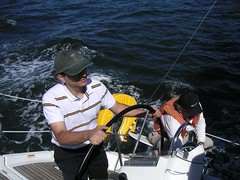
And on the seventh day He said, "Oh, one more thing..."
-Jobs 3:15
Stuff that's on my mind...
 people had sailed before. At the dock, we found our sailboat, a 42-foot Bēnēteau 423. The Bēnēteau 423 was one of the top 10 sailboats of 2003 according to Sail Magazine, and it's price is around $165,000. Not bad at all! Upon boarding the sailboat, we met Stan, our skipper, who had been in the Coast Guard for 20 years before becoming a sailing instructor for the Modern Sailing Academy in Sausalito. He explained all the boat terminology (port is left, starboard is right when facing the ship's front, or rather, the bow). And taught us how to work the sails. We used the motor to get out of the docks, hung around the start line until the race started, and set sail towards San Francisco.
people had sailed before. At the dock, we found our sailboat, a 42-foot Bēnēteau 423. The Bēnēteau 423 was one of the top 10 sailboats of 2003 according to Sail Magazine, and it's price is around $165,000. Not bad at all! Upon boarding the sailboat, we met Stan, our skipper, who had been in the Coast Guard for 20 years before becoming a sailing instructor for the Modern Sailing Academy in Sausalito. He explained all the boat terminology (port is left, starboard is right when facing the ship's front, or rather, the bow). And taught us how to work the sails. We used the motor to get out of the docks, hung around the start line until the race started, and set sail towards San Francisco. ropes). Since I had never been in a sailboat, I didn't expect it to lean that much. It's a little scary at first, but I was assured by Stan that they don't tip over under normal conditions (i.e. not in a hurricane). Driving that thing was fun, but it required a lot of attention. Basically if you let your attention drift for 10 seconds, you would slightly change course and lose the lift. If you lose the lift often enough, your skipper can order a Keelhauling, which I've been told is not pleasant. I must have done allright because we were going at about 3 knots towards San Francisco.
ropes). Since I had never been in a sailboat, I didn't expect it to lean that much. It's a little scary at first, but I was assured by Stan that they don't tip over under normal conditions (i.e. not in a hurricane). Driving that thing was fun, but it required a lot of attention. Basically if you let your attention drift for 10 seconds, you would slightly change course and lose the lift. If you lose the lift often enough, your skipper can order a Keelhauling, which I've been told is not pleasant. I must have done allright because we were going at about 3 knots towards San Francisco.
 Seeing Alcatraz up close was quite a thrill. I have wanted to go to Alcatraz since 1994, when I first visited San Francisco, but because of various reasons, I have never taken a tour of "The Rock". After we went around Alcatraz, we headed back towards Sausalito, and the finish line. During that last segment, even though we were going more or less against the wind, we did a pretty good time. We won the race, crossing the finish line 7 minutes before the next sailboat.
Seeing Alcatraz up close was quite a thrill. I have wanted to go to Alcatraz since 1994, when I first visited San Francisco, but because of various reasons, I have never taken a tour of "The Rock". After we went around Alcatraz, we headed back towards Sausalito, and the finish line. During that last segment, even though we were going more or less against the wind, we did a pretty good time. We won the race, crossing the finish line 7 minutes before the next sailboat.
 to the other side. It was amazing being under the bridge. We got a little taste of the ocean too, with a slightly rougher sea than what the bay had been. After a quick turn, we got back to the dock, returned the sailboat and called it a day.
to the other side. It was amazing being under the bridge. We got a little taste of the ocean too, with a slightly rougher sea than what the bay had been. After a quick turn, we got back to the dock, returned the sailboat and called it a day.Technorati Tags: BitKeeper, BitMover, Sailing, San Francisco
Technorati Tags: windows
Stop-a and at the OpenBoot prompt type:ok? setenv diag-switch? true
Option-Command-o-f. Once you're in Apple's OpenFirmware prompt, you can also turn diag-switch? on. Guess what happens... yup, a few minutes staring at a dark screen thinking the machine had died. Only Apple computers don't really have a serial port.
BK is a complicated system, there are >10,000 replicas of the BK database holding Linux floating around. If a problem starts moving through those there is no way to fix them all by hand. This happened once before, a user tweaked the ChangeSet file, and it costs $35,000 plus a custom release to fix it.Many people deemed this problem as a simple bug in the BitKeeper server. Others saw it as bad design. Few people understood that it was neither, and the corruption would have been inevitable.